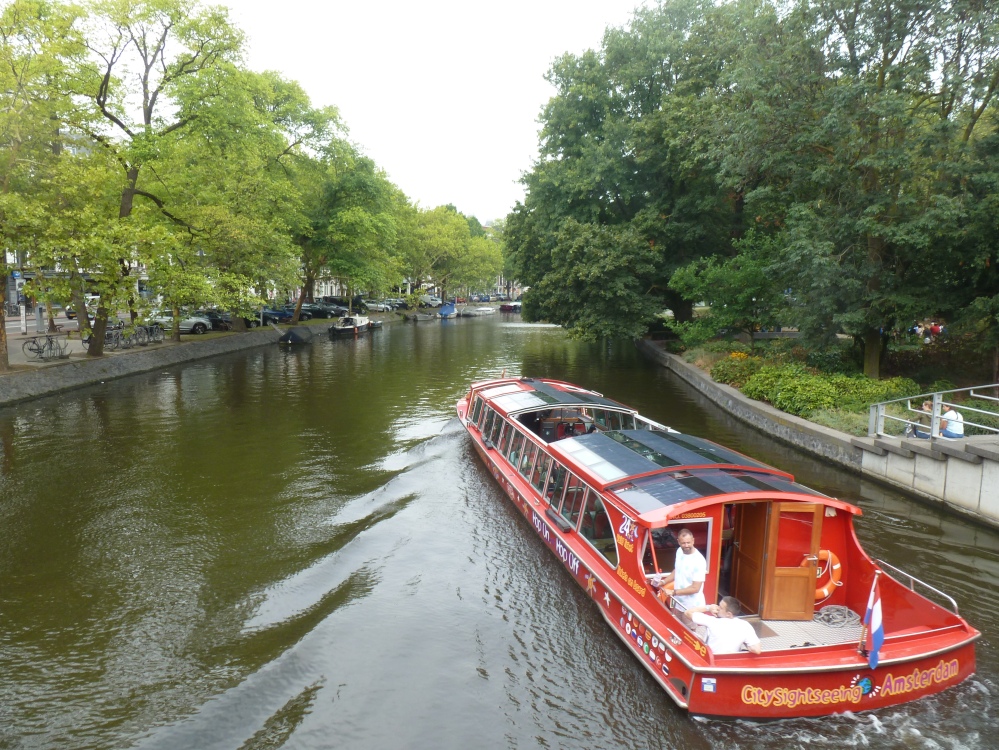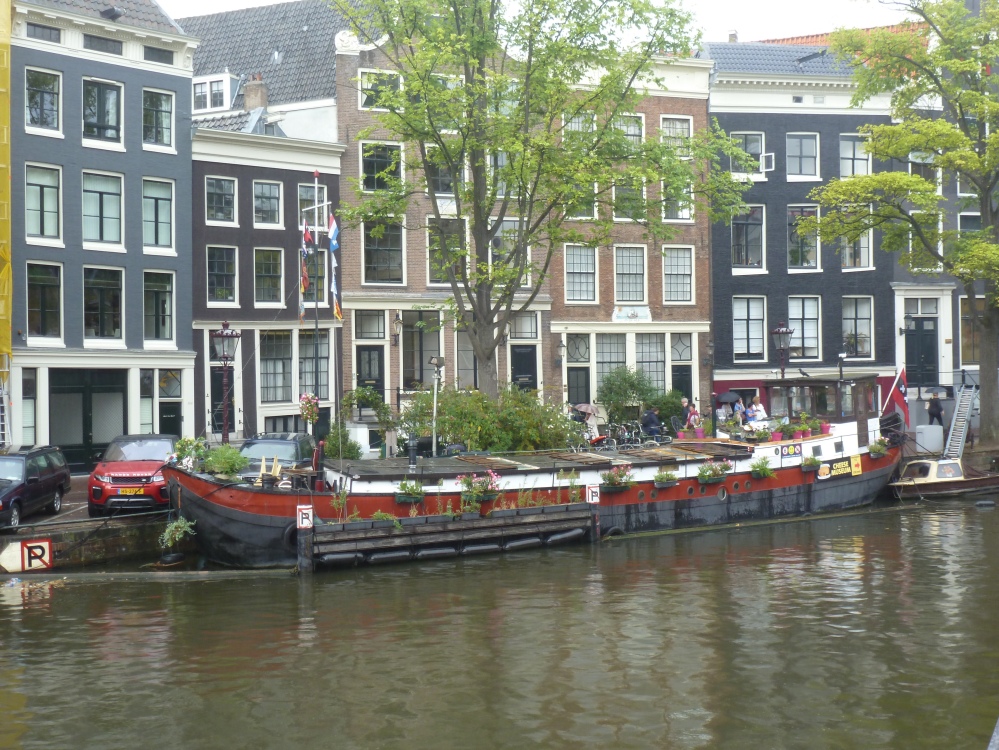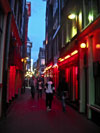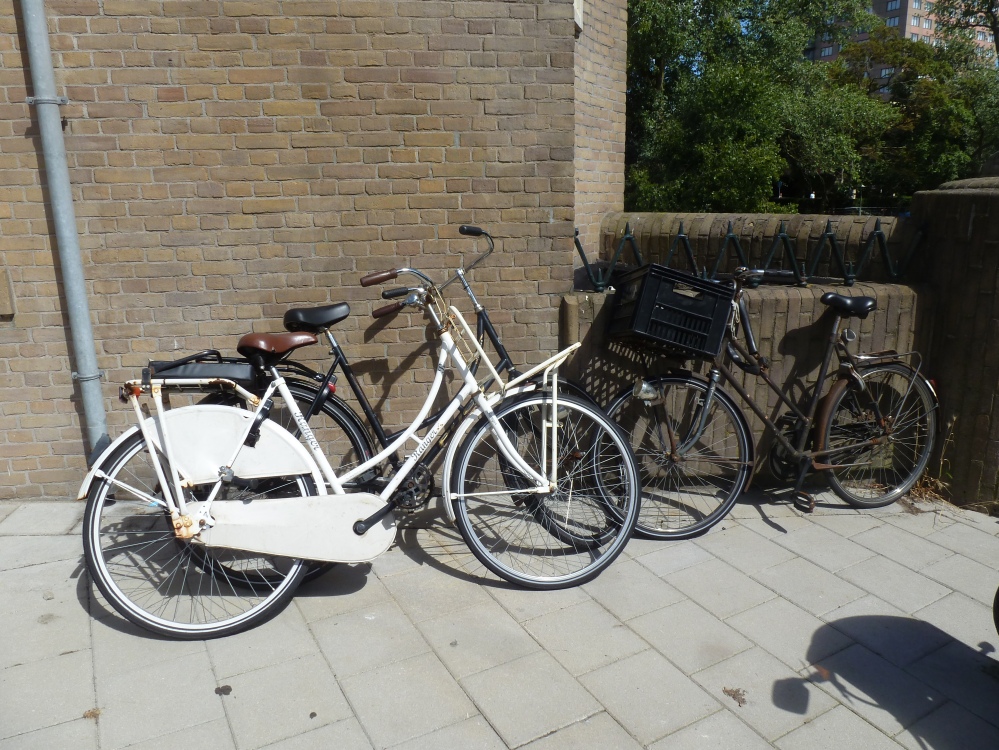This is my fourth entry. If you missed the other three and want to catch up, go to http://www.kenismsblog.com and look for the “Journey Begins”, “Somewhere over Ireland”, and “A little History and a little Beer”.
I just finished my third day in Amsterdam and felt it appropriate to give a summary, caution…. I didn’t say it would be brief. Many things about the city stuck out for me. It is ironic that I grew up in a small town that was mostly Dutch descendants but it took me until day three to put that in perspective when I saw a familar name on a boat slip.
Enough about reminiscing. In no particular order, these are the five things that most impressed me or at least left my opinion changed…. canals, bikes, trams, pulleys and the red light district.
Canals are laid out like beltlines in Amsterdam and they not only provide an alternate transportation system, they drain the city, divide the city into neighborhoods and provide a landmark for navigating through the city. They flow gracefully as they surround the city and provide dock sites for countless houseboats. The tour boats ply their waterways all day and into the evening, giving all who climb onboard a very different view and a unique perspective on the city.

As you navigate the city and especially its canals, you will notice pulleys protruding from the upper eaves of almost every building. They look perfectly part of the architecture but are utilitarian in purpose. Taxes assessed against buildings in the city were originally based on the frontage of the building. As a result, the locals reduced their tax liability by building their houses perpendicular to the street they faced. This reduced their taxable frontage but meant the buildings were extremely narrow, often no more than ten to twelve feet. This adaptation left them too narrow to move anything of size into the building much less up to the upper floors. The solution was pulleys. The pulleys allowed the tenants to simple hoist their furniture and goods up to and through the windows. The effect is impressive. Some buildings, built very close to the canal bank, would go so far as to slant the upper floors out over the street below to further advantage the canals.

One feature of Amsterdam that stood out for me was the trams. I have been to cities with tram systems, but Amsterdam takes it very seriously. The trams run everywhere and on time and timely. I never had to wait more than ten minutes nor did I have to work very hard on what tram I needed to board. To make life even better, the passes are inexpensive and so easy to use. Scan in, scan out. Jump on, jump off. Now I admit we scanned out improperly one night causing the system to think we had ridden all night, but after a slight inconvenience, a stop at the conductor’s desk, we were back on track, no pun intended. Next time I am sitting in a line of semi-parked cars on our beltline, I will be thinking longingly of what I can only wish we had. Thank you Amsterdam. You gave me every opportunity to explore your city.
It would seem a glaring ommission if I were to skip over the red light district. Afterall, it is likely the first thing you thought of when Amsterdam was mentioned. I am happy to tell you it exists. It is a business but it is not quite as visible as your imgination might project. It is in fact, well marked and yet hard to actually find. As you wind through the streets and alleyways of “old town”, you find yourself craning your neck looking at every window for a glimpse. At best you will find the occassional bikini clad mistress in one of the windows. The red light district is historic in nature and actually meant to keep the city cleaner and the business ironically less obtrusive. The Dutch were traders and Amsterdam was their base. As such, there were plenty of sailors and traders to make prostituion a very profitable endevour. Without the control of the red light district, the confrontation would be much more…well confrontational. The red light district provided control of the taxes and the location. Did I go looking for the district, of course I did. But then everyone does. It’s just history you see and pretty much required.

I have saved the best for last, the bikes. I can only try to do this topic justice. There are, at best estimate, over 600,000 bikes in Amsterdam. Considering the population is 900,000….well, pretty impressive. I suspect that World War Two had a lot to do with it’s growth, the flat landscape and attention to bike lanes only add to the attractiveness of this mode of transportation.
The numbers are one thing. I knew, because everyone told me, that there were going to be bikes everywhere. But it is so much more. In America we ride fancy bikes, often ten speeds at the very least, hunched over our handlebars and attempting to see how far and how fast we can ride. Some might use their bikes to get somewhere, but most of us just ride to ride.
In Amsterdam it is all about the transportation. The first striking difference is the bike itself.

They are utilitarian in design, three speed at best, with straight handlebars, up high where you can ride erect, eyes on the road ahead. The bikes almost look old fashioned with their cargo boxes, child seats and saddlebags attached. But the effect is so different. Bike riders ride, no, glide by effortlessly, easily keeping pace with the cars, buses and trams that travel one lane over. This creates a slight problem for the uneducated in that they own those bike lanes and the pedestrian must be ever vigil. I had been warned about that and had envisioned the American version of a speeding biker, finger erect, letting me know I had invaded their sacred space. But it was so different. They owned the bike lane, even earned it with their elegant simplicity, but it was just the gentle jingle of their bike bells that you would ever hear. Two days in, I was getting accustomed to their prescence and had come to respect their right to the lane. Afterall, they were going somewhere, be it to work, the market or to some other event that they would arrive at without any addition to the carbon footprint. Just tire tracks left quietly by human effort alone.
There is really no way to fully describe Amsterdam. I and other travelers can tell you our stories but in truth, you will just have to experience it. I hope that you will one day get the chance and I truly hope you won’t miss the opportunity.
It is almost midnight here and the river boat I am on, the Viking Ingvi, has just left the pier. Tomorrow I get to expand my exploration as we head up the Rhine to new sights and new opportunities. I hope you will keep following me, but until the next edition, I am off.

Did you by chance notice the white lace curtains in the windows? We were told that during WW II, the black out curtains were so morbid that they were one of the first things to go when the war ended. The Dutch said, “Never again.” Also, apartment buildings with outside decks were built post-WW II. No decks = pre WW II.
Keep the blogs coming. Enjoy your cruise. Viking lines?
Hi to Deb
LikeLiked by 1 person
Missed the curtains but great information. We are on a Viking Cruise up the Rhine ending at Basel.
LikeLiked by 1 person
Of course, you tried some/a lot of the Dutch chocolate. 😍 We’ve only been on one cruise, a Viking Cruise from Paris to Normandy a few years ago. Ages and health will probably keep us mostly home in the future. Loved😛 the small number of people. Didn’t feel like we were traveling with everyone in MHoreb. Yes, I’ve been following your blogs. Keep ‘em coming. Enjoy the cruise and scenery and food and….
LikeLiked by 1 person